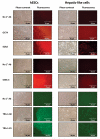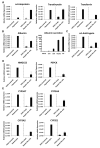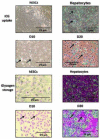Differentiation of human embryonic stem cells along a hepatic lineage
- PMID: 21241686
- PMCID: PMC3073319
- DOI: 10.1016/j.cbi.2011.01.009
Differentiation of human embryonic stem cells along a hepatic lineage
Abstract
The limited availability of hepatic tissue suitable for the treatment of liver disease and drug discovery research advances the generation of hepatic-like cells from alternative sources as a valuable approach. In this investigation we exploited a unique hepatic differentiation approach to generate hepatocyte-like cells from human embryonic stem cells (hESCs). hESCs were cultured for 10-20 days on collagen substrate in highly defined and serum free hepatocyte media. The resulting cell populations exhibited hepatic cell-like morphology and were characterized with a variety of biological endpoint analyses. Real-time PCR analysis demonstrated that mRNA expression of the 'stemness' marker genes NANOG and alkaline phosphatase in the differentiated cells was significantly reduced, findings that were functionally validated using alkaline phosphatase activity detection measures. Immunofluorescence studies revealed attenuated levels of the 'stemness' markers OCT4, SOX2, SSEA-3, TRA-1-60, and TRA-1-81 in the hepatic-like cell population. The hepatic character of the cells was evaluated additionally by real-time PCR analyses that demonstrated increased mRNA expression of the hepatic transcription factors FOXA1, C/EBPα, and HNF1α, the nuclear receptors CAR, RXRα, PPARα, and HNF4α, the liver-generated plasma proteins α-fetoprotein, transthyretin, transferrin, and albumin, the protease inhibitor α-1-antitrypsin, metabolic enzymes HMGCS2, PEPCK, and biotransformation enzymes CYP3A7, CYP3A4, CYP3A5, and CYP2E1. Indocyanine green uptake albumin secretion and glycogen storage capacity further confirmed acquisition of hepatic function. These studies define an expeditious methodology that facilitates the differentiation of hESCs along a hepatic lineage and provide a framework for their subsequent use in pharmacological and toxicological research applications requiring a renewable supply of human hepatocytes.
2011 Elsevier Ireland Ltd. All rights reserved.
Figures







Similar articles
-
Stable expression of FoxA1 promotes pluripotent P19 embryonal carcinoma cells to be neural stem-like cells.Gene Expr. 2012;15(4):153-62. doi: 10.3727/105221612x13372578119571. Gene Expr. 2012. PMID: 22783724 Free PMC article.
-
Effects of pulsed electromagnetic field on differentiation of HUES-17 human embryonic stem cell line.Int J Mol Sci. 2014 Aug 14;15(8):14180-90. doi: 10.3390/ijms150814180. Int J Mol Sci. 2014. PMID: 25196518 Free PMC article.
-
Oct4 expression in in-vitro-produced sheep blastocysts and embryonic-stem-like cells.Cell Biol Int. 2009 Dec 16;34(1):53-60. doi: 10.1042/CBI20090008. Cell Biol Int. 2009. PMID: 19947952
-
Human amnion-derived cells as a reliable source of stem cells.Curr Mol Med. 2012 Dec;12(10):1340-9. doi: 10.2174/156652412803833625. Curr Mol Med. 2012. PMID: 23016591 Review.
-
Networks of Transcription Factors for Oct4 Expression in Mice.DNA Cell Biol. 2017 Sep;36(9):725-736. doi: 10.1089/dna.2017.3780. Epub 2017 Jul 21. DNA Cell Biol. 2017. PMID: 28731785 Review.
Cited by
-
Enhanced hepatic differentiation of rat bone marrow-derived mesenchymal stem cells in spheroidal aggregate culture on a decellularized liver scaffold.Int J Mol Med. 2016 Aug;38(2):457-65. doi: 10.3892/ijmm.2016.2638. Epub 2016 Jun 14. Int J Mol Med. 2016. PMID: 27314916 Free PMC article.
-
In vitro models for liver toxicity testing.Toxicol Res (Camb). 2013 Jan 1;2(1):23-39. doi: 10.1039/C2TX20051A. Epub 2012 Nov 23. Toxicol Res (Camb). 2013. PMID: 23495363 Free PMC article.
-
Chalcone-Induced Apoptosis through Caspase-Dependent Intrinsic Pathways in Human Hepatocellular Carcinoma Cells.Int J Mol Sci. 2016 Feb 22;17(2):260. doi: 10.3390/ijms17020260. Int J Mol Sci. 2016. PMID: 26907262 Free PMC article.
-
CINPA1 is an inhibitor of constitutive androstane receptor that does not activate pregnane X receptor.Mol Pharmacol. 2015 May;87(5):878-89. doi: 10.1124/mol.115.097782. Epub 2015 Mar 11. Mol Pharmacol. 2015. PMID: 25762023 Free PMC article.
-
Stem cells in liver regeneration and their potential clinical applications.Stem Cell Rev Rep. 2013 Oct;9(5):668-84. doi: 10.1007/s12015-013-9437-4. Stem Cell Rev Rep. 2013. PMID: 23526206 Review.
References
-
- Cao S, Esquivel CO, Keeffe EB. New approaches to supporting the failing liver. Annu Rev Med. 1998;49:85–94. - PubMed
-
- Malhi H, Gupta S. Hepatocyte transplantation: new horizons and challenges. J Hepatobiliary Pancreat Surg. 2001;8:40–50. - PubMed
-
- Schwartz RE, Linehan JL, Painschab MS, Hu WS, Verfaillie CM, Kaufman DS. Defined conditions for development of functional hepatic cells from human embryonic stem cells. Stem Cells Dev. 2005;14:643–55. - PubMed
-
- Lemaigre F, Zaret KS. Liver development update: new embryo models, cell lineage control, and morphogenesis. Curr Opin Genet Dev. 2004;14:582–90. - PubMed
Publication types
MeSH terms
Substances
Grants and funding
LinkOut - more resources
Full Text Sources
Other Literature Sources
Research Materials

